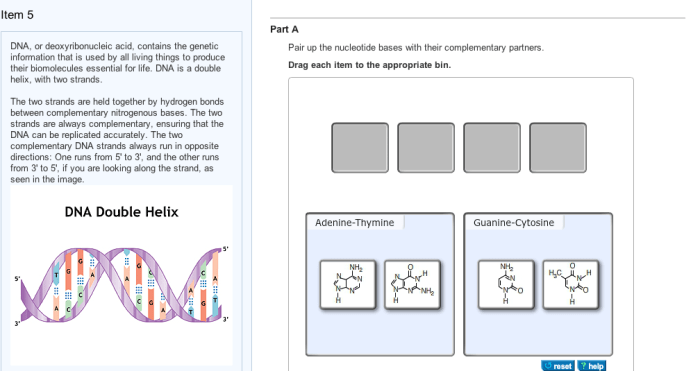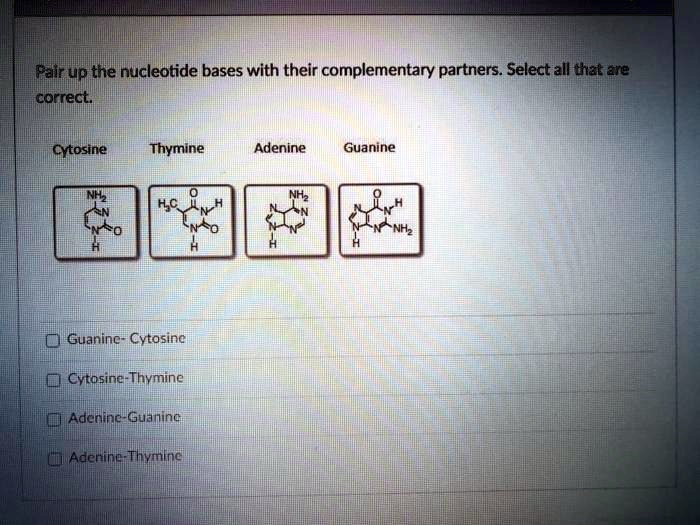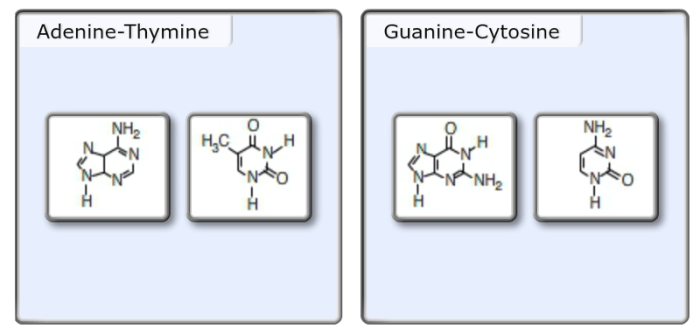Pair up the nucleotide bases with their complementary partners – As the topic of pairing up nucleotide bases with their complementary partners takes center stage, this opening passage invites readers into a realm of scientific exploration. Delving into the intricacies of DNA and RNA, we embark on a journey to unravel the fundamental principles that govern the very essence of genetic information.
Nucleotide base pairing, the cornerstone of molecular biology, plays a pivotal role in maintaining the integrity and perpetuation of genetic material. Through the precise and specific pairing of complementary bases, the genetic code is faithfully transmitted from one generation to the next, ensuring the continuity of life as we know it.
Nucleotide Base Pairing: Pair Up The Nucleotide Bases With Their Complementary Partners

In the realm of molecular biology, the concept of base pairing plays a pivotal role in the structure and function of DNA and RNA. Base pairing refers to the specific and complementary pairing of nucleotide bases, which are the building blocks of these nucleic acids.
The nucleotide bases adenine (A), cytosine (C), guanine (G), and thymine (T) in DNA, or uracil (U) in RNA, exhibit a precise pairing pattern. Adenine pairs exclusively with thymine (A-T) in DNA or uracil (A-U) in RNA, while cytosine pairs exclusively with guanine (C-G).
Hydrogen Bonding
The stability of base pairs is attributed to hydrogen bonding, a weak but highly specific interaction between hydrogen atoms and electronegative atoms. In A-T/U base pairs, two hydrogen bonds form between the N-H group of adenine and the O of thymine/uracil, while in C-G base pairs, three hydrogen bonds form between the N-H groups of cytosine and the O and N atoms of guanine.
Antiparallel Strands
DNA consists of two strands that run in opposite directions, known as antiparallel strands. This orientation allows for the formation of complementary base pairs between the two strands, creating the iconic double helix structure. The 5′ end of one strand faces the 3′ end of the other, enabling the hydrogen bonding interactions that hold the strands together.
Base Pairing in DNA Replication
During DNA replication, the double helix unwinds and each strand serves as a template for the synthesis of a new complementary strand. The specific base pairing rules ensure that the newly synthesized strands are identical to the original strands, preserving the genetic information.
Base Pairing in Transcription
Transcription is the process by which DNA is used to create RNA. During transcription, one strand of DNA serves as a template for the synthesis of a complementary RNA molecule. The RNA molecule contains uracil (U) instead of thymine (T) and is typically single-stranded.
Applications of Base Pairing, Pair up the nucleotide bases with their complementary partners
The understanding of base pairing has revolutionized molecular biology and has led to numerous applications, including:
- Polymerase Chain Reaction (PCR):PCR amplifies specific DNA sequences by utilizing the principles of base pairing to create multiple copies of the target DNA.
- DNA Sequencing:DNA sequencing determines the order of nucleotide bases in a DNA molecule by exploiting base pairing to identify the complementary sequence.
- Genetic Engineering:Genetic engineering involves modifying or manipulating DNA by utilizing base pairing to introduce or alter specific genes or DNA sequences.
FAQ Guide
What is the significance of base pairing in DNA replication?
Base pairing ensures the accurate replication of genetic information during DNA replication. The complementary pairing of bases (A-T/U, C-G) ensures that each newly synthesized DNA strand is an exact copy of the original template strand, preserving the integrity of genetic information.
How does hydrogen bonding contribute to the stability of base pairs?
Hydrogen bonding is a crucial factor in stabilizing base pairs. The specific pattern of hydrogen bonds between A-T/U (two hydrogen bonds) and C-G (three hydrogen bonds) contributes to the stability and specificity of base pairing, ensuring the fidelity of genetic information.
What is the role of base pairing in transcription?
In transcription, base pairing guides the synthesis of RNA molecules from a DNA template. The RNA polymerase enzyme recognizes and pairs complementary RNA nucleotides (A-U, C-G) with the DNA template strand, resulting in the production of an RNA molecule that carries the genetic information.


